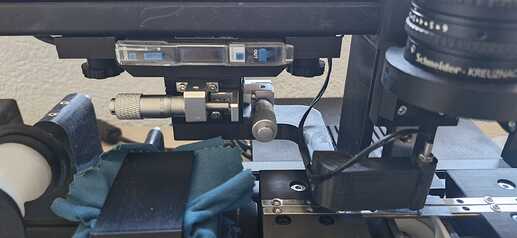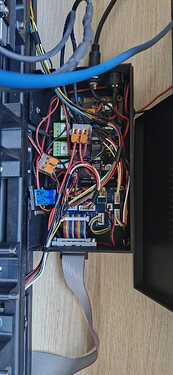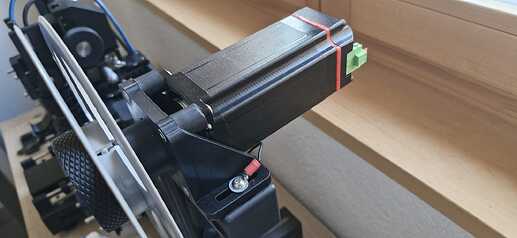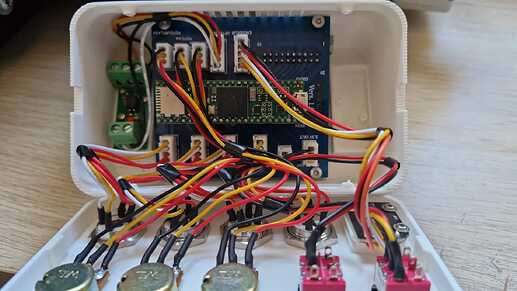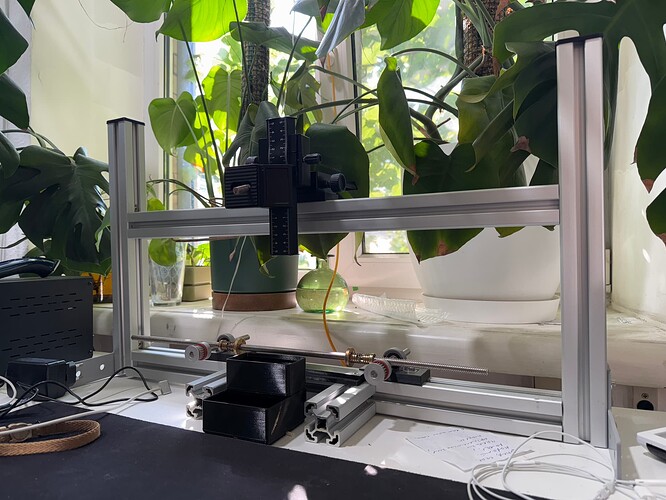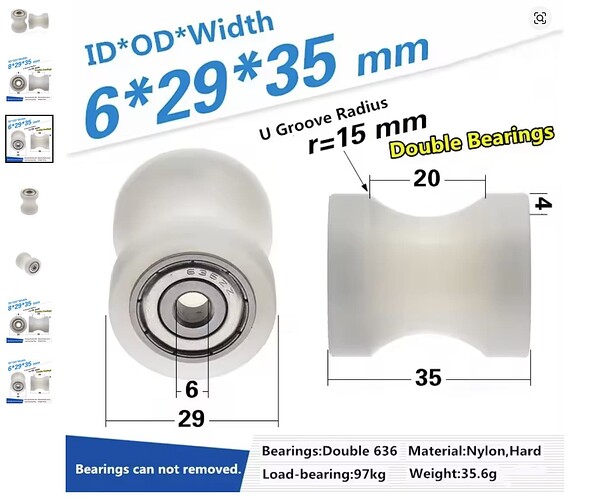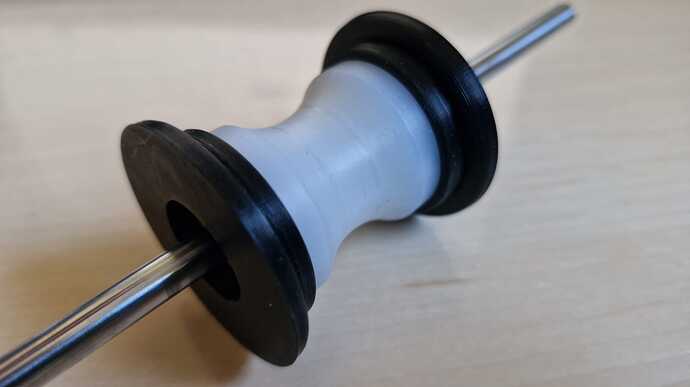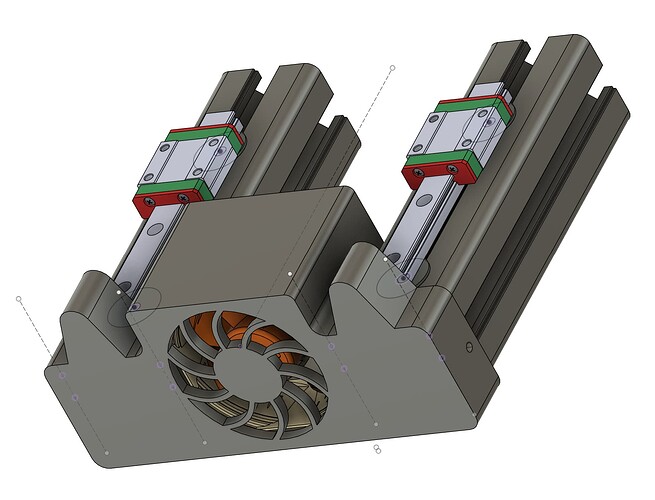Still on the principle of modules, there’s a new film cleaning system, just before the capture window.
The micro-fibre is still impregnated with iso alcohol.
How do you deal with accumulating dust particles? ![]()
The films are first cleaned with a micro-fibre cloth and alcohol, using the traditional method.
When the film passes through the scanner, very little dust remains.
The gripper is lightly soaked in alcohol and can be moved sideways during scanning.
The aim is to clean the film one last time, just before it passes under the camera.
I’ve made several improvements to make the scanner fully modular. Each component is interchangeable, and upgrading one module has no direct impact on the rest of the machine.
-The first modification is the perforation detection laser.
This is a single unit that physically integrates all the necessary components. It connects to the bypass box at the rear of the scanner via a single socket.
- The junction box houses power supplies of various voltages, as well as a connection board that links all the modules (yes, I know the assembly could be neater).
- The stepper motors have been upgraded to more powerful models with an 8mm shaft, making them better suited to handling sometimes heavy 35mm film. These motors have built-in drivers, eliminating the need for separate drivers elsewhere in the scanner. The goal remains to maintain a fully modular design.
- The last photo shows the control box, now equipped with a Teensy microcontroller.
As this device is of no interest to anyone on this forum, I’m not going to continue to share its development with you, without any resentment on my part.
There has been a lot of talk of development on this forum recently, but obviously a lot of difficulty in putting in the work to make it happen. I’m afraid that these good intentions will get bogged down in a lot of theories that won’t lead to anything.
Good luck to you all!
Roland, I do not believe that is the case, everyone benefits from other builds problem solving. You have a great built (just look at the number of likes on your posts).
Kinograph is the central project of the forum, and although we can provide feedback, it is Matthew who leads that one.
Everyone is doing it their own way and sharing different levels of information. One cannot impose their ideas on to other projects.
I also thoroughly enjoy reading / seeing how people solve various issues in their builds.
Please don’t stop sharing, no matter how technical other posts are.
Well, I find your posts quite interesting and inspiring. Please continue to post!
Sure, everyone does as they please. But if the proposed technical choices are neither read, nor discussed, or even ignored, then my participation is pointless. What I propose is concrete and reproducible—maybe not perfect, I’m aware of that, but certainly not just theoretical.
I made a mistake in thinking that this forum was not about a project that had already been decided.
In reality, you are heading toward a clone of machines currently on the market by copying solutions already implemented by other professionals. This absence of risk is certainly the best way to avoid making mistakes, but how boring it is.
Roland, not sure if your frustration is that Kinograph has not considered your design, or that someone has not approached you to build it… or both.
I would love to build a machine like yours, but I cannot afford it… and the main reason why I am stuck on the frames-per-minute rather than the frames-per-second.
Why does Kinograph not consider your approach, I do not know. @matthewepler would be the one.
If I had the budget, I would certainly prefer a configuration/structure similar to yours, than what Kinograph is proposing.
In my view, and everyone is entitled to their own, you have not yet shared enough information to make a determination on how easy/hard/affordable/expensive it will be… and people sometimes read over or misread. I did so… I thought most of your parts were machined (actually complemented you for it) and in your first post you made clear that these were 3D printed parts (with the frame).
There is a facebook group -which I am not part of- were all the MovieStuff buyers are congregating (about 700 members). Many new buyers never got a product and lost their money, so certainly they will be receptive.
If you are looking for builders, another option is to launch your own project (like gugusse or Tscann 8). I am certainly impressed at how many Tscann-8 have been made
Hope this feedback helps, and hope the project finds a path were your great work is realized in other machines.
I appreciate your posts. I simply don’t have enough knowledge to make a meaningful contribution to the conversation. I will probably never build a “kinograph” but when I eventually do build a scanner it will probably be a Frankenstein machine using the different ideas presented in this forum with design decisions based upon budget, tools available and my skill to implement a feature. So even if a person’s design contributions are never adopted as part of an official kinograph build, posts like your’s and other forum members are very beneficial to individuals like me. I know it takes time to document and share your machine and the design decisions you’ve made. Please continue to share. Sometimes just the process of writing things down helps a person work through a problem.
I’ve been lurking around reading this forum for a long time (so much interesting development going on out there!) and just got my account set registerred a few minutes ago. I must say I have enjoyed reading your posts about your build and hope you will reconsider.
The discussion forum isn’t the Kinograph project, the Kinograph project is a singular project but this forum has always welcomed contributions from DIYers and hosts many different projects from other people like yourself.
What speeds does your all-format scanner achieve?
The Kinograph is an open-source project rather than a DIY project. Matthew’s design criteria is really the MVP approach so far as I can tell. You create your minimum design first and get it working reliably, and then when you “add functionality” it goes through the same process. It’s a slower more methodical process, but ensures you don’t leave behind usability or reliability at the expense of chasing functionality in the here and now. That’s different to a traditional DIY approach, but there are significant similarities too. Every DIY project does most things in “a singular way”. For example, a DIY build will have one backlight module. The DIY designer may make changes to it over time, but they don’t spend their time making 2 or 3 different modules that they can change at will.
The Kinograph designs will be open-source, so once the Kinograph’s light module v 1.0 exists as a designed defined module then anyone can build it themselves from scratch, or they can purchase it pre-built from someone who will build it for them. It won’t need to be used in a Kinograph either, you could could take that one component and use it in any DIY scanner that you can fit it in, or re-engineer it to make it smaller to fit it in a tighter space etc. So that’s where the Kinorgraph project would be potentially helping the DIY projects.
But there’s no reason that it should stop there of course, the other raw parts once open-sourced and reproducible can also then be supplied as alternatives to the commercial products. One thing that has been talked before are PTRs. At the moment for PTRs you have to buy them from Kodak (or the scanner manufacturers). Matthew has talked about an alternative way of using low-cost sleeves instead (these “traction roller sleeves” have effectively the same material as PTRs), or manufacturing PTRs as a drop-in replacement for Kodak’s. Once you have the open-source alternative they’re no longer in the hands of the commercial companies making them, and you can potentially bring the cost down for both Kinograph users and DIYers who want them. Same thing with rollers. You can buy professional 35/16mm rollers retail, but they are expensive and you can’t buy them as 35/16/8 nor as 16/8 nor as machined polished chrome, etc.
Either way I hope you’ll stick around with your project, the more unique ideas there are the better for problem-solving and giving people new ideas with their own projects.
Thank you for your response and comments.
The Kinescope project, as you describe it, perfectly aligns with what I have developed. A bit more attention on your part might have made this clear before over-theorizing the tasks.
- A highly stable, universal 40x40 profile chassis that can be adapted as needed.
- No machining required (!).
- Standard fastenings for easy module addition or removal.
- A central box housing all electronic connections.
These modules are compatible with any scanner using this type of profile. For example, my lighting module can be integrated into any scanner, as can the traction motors, camera column, or perforation detection module.
The scanning speed ranges from 1 to 28 fps, with a recommended optimal speed of 16 fps.
Is there a published design for this scanner? It looks great and I’d like to try to build one, after starting a project repurposing a 16mm scanner but abandoning it after switching to S16 filming.
Oh I can see your disappointment and lack of communication. All I can do is kindly ask you to continue. Your machine design inspired me to kickstart my own development based on your core idea. Unfortunately I’m still far from finishing as I’m learning simultaneously and more focused on film developing machine now while surviving war in Ukraine, which is another blocker unfortunately.
Basically I’m following your steps and deeply appreciate your knowledge. Sharing the frame of my machine to proof that I’m still on my way towards working prototype.
Great news—I’m really happy to see your project moving forward! I’m of course available if you have any questions. I thought the photos I posted would be enough to inform anyone who might be interested, but I’d be happy to provide more details if needed—just let me know!
I’m also curious: what will the gears and the worm gear in your photo be used for?
Wishing you strength as you go through these challenging times. The inaction of our leaders is troubling for us as well, even if we are still relatively protected for now.
I’ve stopped at worm wheels as they have precise dimension for 16mm film (two O-Rings inside lift up the film plane on sprockets ideally). I had some troubles with 3D printed wheels and their alignments on bearing.
Also I’ve acquired Basler ACA2500-GC camera and Keyence LV-S62 laser assembly, but had no time to merry them and check the triggering.
Also I’ve got set of different rails, polished the gate assembly, so my next step is designing the fixture for the gate and engineering the rest. My only problem that isn’t solved yet is the lighting block. I was thinking to use constant light fixture (I own Cinestill film scanning light that is great) and now it feels like I need flash light module for Basler camera for better exposure control.
Overall my main blocker is the CAD modeling which is somewhat tricky for me. It moves on but really slow. However I’m sure that I’ll make it work sooner or later.
I use this to guide film (Aliexpress). The advantage is that it works for all formats. The manufacturing isn’t ultra-precise, but it works well.
I only made two sidewalls for the 35mm format, which are glued together.
Perhaps the most difficult part to draw is this one:
01 - Cache ventilateur.stl (306.3 KB)
Tolerances between 3D printers vary. But it’s worth a try.
For the film guide, I can also give you some information if you’d like.
Omg, thank you so much for sharing those. You’ve really sparked me now to get my hands to it. It’s actually makes way more sense to have bearings inside the roller and not on the fixture (which will prevent the shaft from tilting over tension). I’ll give those a try and will share my progress later this week.
And I’ll say it once again - I really appreciate your help and advice here. Gives plenty of motivation.
